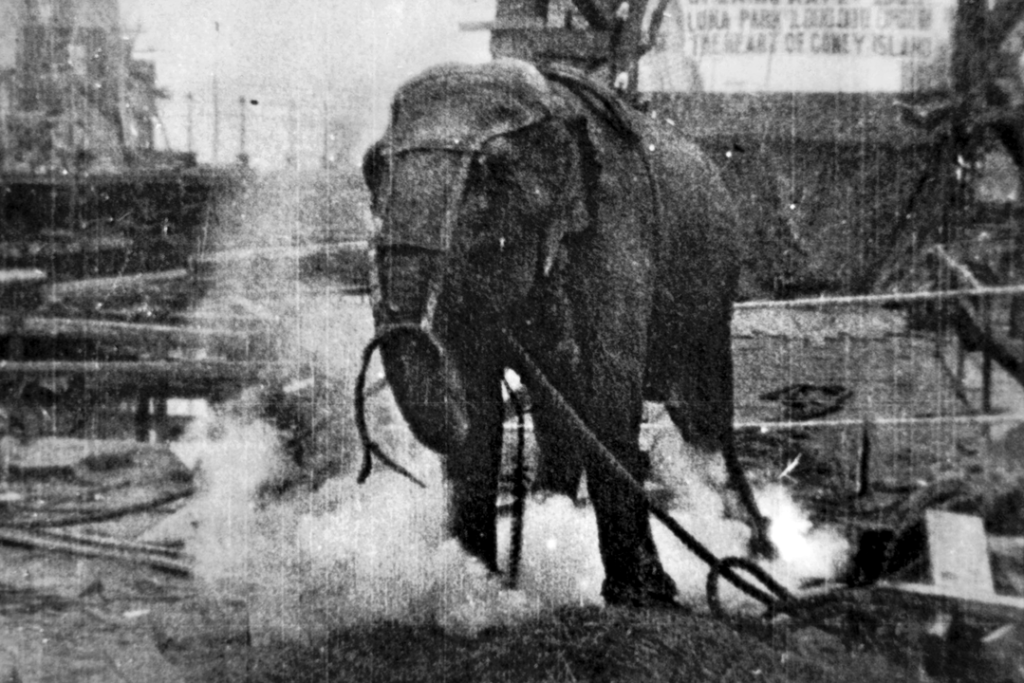Public executions were a common part of life throughout medieval Europe, and following the colonisation of the Americas during the 1500s, the practice soon made its way across the Atlantic. However, by the late 1800s most states had passed laws banning public execution for fear of the social repercussions they might have on an otherwise civilised public. Thereafter, in lieu of public executions of criminals, the American public satisfied its need for justice and retribution through the execution of animals that had ‘murdered’ their handlers.
Why Elephants?
Elephants were an exotic curiosity; known to be highly intelligent and capable of empathy, elephants were easily anthropomorphised with human qualities. Due to their enormous size and formidable strength, they were also viewed as an apt demonstration of man’s dominance over nature and thus the rightful order of the world. Though many captive elephants were beloved by audiences, there was no illusion that they were tame.
Elephants were therefore seen as both lovable and dangerous at the same time. Indeed, circuses often played up the danger of their captive elephants ‘going mad’ in order to inflate the bravado of their trade. Due to the stress of captivity, it was not uncommon for elephants to lash out at their handlers, or else become confused or scared during performances, causing numerous injuries and deaths. Perhaps in a bid to make sense of these deaths, and in an extension of the desire for bloodthirsty spectacle that was now denied by the lack of criminal executions, the public often demanded retribution against the ‘murderous beasts’. Between the 1880s and the 1920s, there were at least 36 cases of elephant executions carried out either by hanging, electrocution, or occasionally firing squad. Many of these were ticketed events, though some were conducted more like impromptu hunts when elephants escaped their captors.
Performance and Spectacle
Executions of dangerous elephants became as much about theatrical performance with a commercial interest as they were about crime and punishment. When an animal became considered too dangerous to be able to perform, circus owners would often stage the animals execution in order to recuperate their lost earnings.
Many different methods were employed to kill elephants who were considered to have become dangerous. Hanging was a common method, and contemporary observers often compared the practice to lynching. For example, in 1916 an elephant crushed its trainer during a parade in Tennessee, which was witnessed by a huge and horrified crowd. The crowd demanded vengeance, and the elephant was later hung from a railroad crane before a large group of spectators.
Execution by electricity was introduced to the US in 1890, and was considered to be the fastest and most humane method of carrying out the death sentence. However, criminal executions by electric chair were typically carried out behind closed doors. Although examples of the electric chair were already a popular sideshow at circuses and carnivals, few people had the opportunity to see such a device in action. The curiosity over this technological marvel only increased the public’s thirst to witness elephant executions.
In perhaps one of the most famous pachyderm executions, the Edison electricity company actually filmed the electrocution of Topsy the elephant at Coney Island in 1903. The film captured the moment the poor creature, having already been fed carrots laced with cyanide and had a rope tied around her neck (just in case), had over 6000 volts passed through her body. The film was later showcased at moving picture exhibitions around the country, and like many other elephant executions was widely reported on in newspapers and periodicals.

A Cruel Blip
Elephant executions became largely obsolete by around 1910, though did still occasionally occur in the Southern states as late as 1936. Societies protesting cruelty and inhumane treatment of animals became more and more prominent following the advent of the 20th century, and circus performances also fell out of fashion in favour of more modern forms of entertainment like cinema. Thankfully, the bizarre phenomenon was short-lived, and can be viewed as a moment when old ideas about punishment met new ideas about crime and justice, with a dash of morbid spectacle thrown in.
Sources and Further Reading
Wood, A. “‘Killing the Elephant’: Murderous Beasts and the Thrill of Retribution, 1885—1930.” The Journal of the Gilded Age and Progressive Era, vol. 11, no. 3, 2012, pp. 405–444